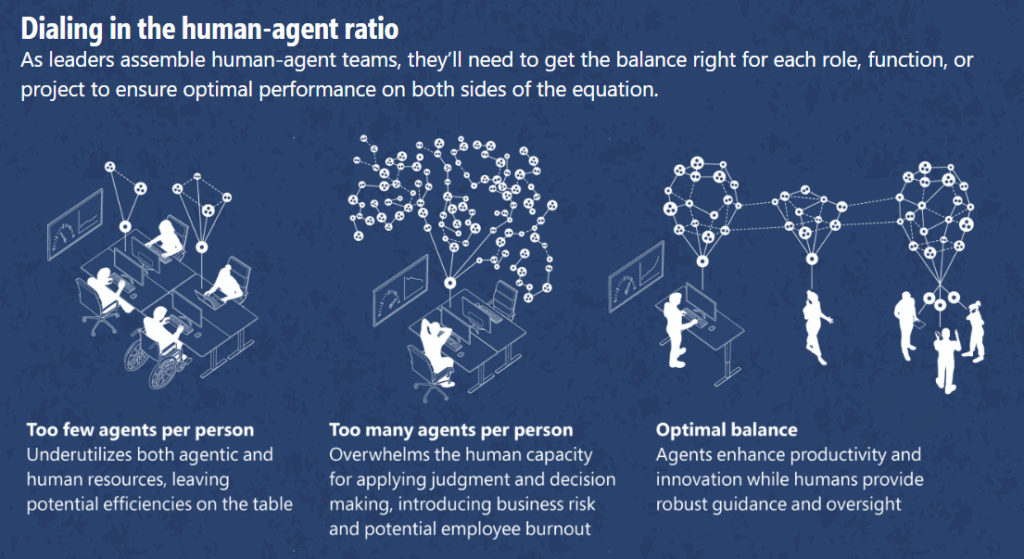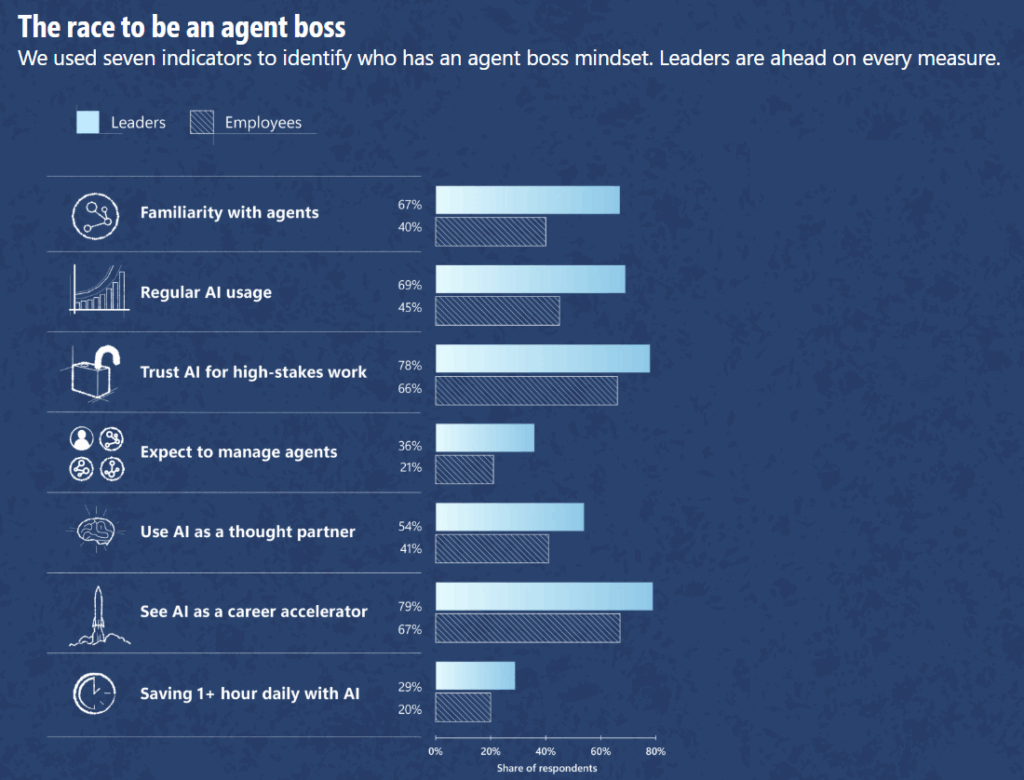
The Birth of the Frontier Firm: Navigating the AI Revolution in Business
We stand on the precipice of a new reality where artificial intelligence possesses remarkable capabilities to reason and solve problems. This update is a major transformation, similar to the Industrial Revolution or the start of the internet, and it will lead to significant technological, societal, and economic changes in the coming decades. The 2025 Work Trend Index Annual Report uses global surveys, Microsoft 365 data, LinkedIn trends, and insights from experts to help leaders and employees adapt to upcoming changes in the workplace. The data reveals a new kind of organisation is emerging – the Frontier Firm.
Leaders recognize the importance of this moment, with 82% believing that this year is crucial for rethinking their strategy and operations. These Frontier Firms are restructuring to effectively utilize AI, driving growth and addressing the gap between business needs and human capabilities. 71% of workers in these firms feel their company is thriving, significantly higher than the global average of 37%. The future will bring significant changes, but human qualities like ambition, creativity, and ingenuity will keep creating new economic value and opportunities.

Intelligence on Tap: A New Durable Good
A key shift identified is that intelligence is no longer just about headcount or current expertise. AI makes intelligence an essential, durable good – abundant, affordable, and scalable on-demand. We’re currently in a situation similar to predicting the internet’s impact before it became widespread—this is where we are with AI.
Amidst growing economic and shareholder pressures, this “intelligence on tap” presents a powerful new lever for growth. It offers a potential solution to the increasing Capacity Gap. Sources show a stark contrast: 53% of leaders see the need for higher productivity, but 80% of the global workforce feels they lack the time or energy to do their jobs well. Digital distractions, such as meetings, emails, and notifications, interrupt employees every 2 minutes on average. To address this gap, 82% of leaders plan to use digital labor to grow their workforce in the next 12 to 18 months.
Access to digital labor is expected to transform existing companies and inspire the creation of new ones that we haven’t imagined yet. Innovation is moving fast: top AI startups on LinkedIn are hiring twice as quickly as Big Tech companies. A large number of tech professionals are leaving Big Tech to join startups, showing a shift toward greater innovation and opportunities in the startup ecosystem. Established companies are adapting, and new challengers are growing, similar to the .com boom. This is changing the fundamental rules of talent acquisition and market competition.
Human-Agent Teams: Reshaping Organisational Structures
As AI continues democratising access to expertise, the traditional, rigid organisational chart gives way to more fluid, outcome-driven Work Charts. These new structures are flexible, using the best mix of human workers and AI agents to meet the business’s needs. 46% of leaders report that their organizations are already using agents to fully automate workstreams or business processes, though the pace of this change varies by business function. The areas seeing the most significant AI investment priorities are customer service, marketing, and product development.
Maximising the effectiveness of these human-agent teams requires a new metric: the human-agent ratio. Leaders need to consider how many agents are required for specific roles and tasks to strike the right balance. And crucially, how many humans are required to guide, oversee, and collaborate with these agents? The optimal ratio will be highly task-specific and will require careful consideration. Organizations need to identify situations where a mix of human and digital labor can surpass AI alone. This is crucial when customers want a personal touch or when society demands human accountability for key decisions, especially in product launches or financial strategies. Balancing human staff and digital agents will change how work is performed and success is measured in the future.

Every Employee Becomes an Agent Boss: Amplifying Impact
Integrating agents into the workforce signals the rise of a new role: the agent boss. This person builds, assigns tasks to, and manages AI agents to enhance their effectiveness and take charge of their career in the AI era. Every employee, from senior leaders to frontline staff, must adopt an “agent boss” mindset. Every employee must think like the CEO of a small, agent-powered startup within the larger organisation. Leaders expect that within five years, 41% of their teams will be involved in training agents and 36% in managing them.
For individuals willing to embrace this change and lean into AI, it presents a powerful opportunity for career acceleration. However, the sources indicate that leaders currently have a head start. Leaders consistently surpass employees in the “agent boss mindset” across seven indicators, such as usage, trust, and perceived career impact. 67% of leaders know about agents, while only 40% of employees do. Additionally, 79% of leaders believe AI will boost their careers, compared to 67% of employees.
Crucially, this transformation will not be confined to senior levels. As AI agents become deeply embedded in daily workflows, roles across every level and function within the workforce will evolve. While 33% of leaders are thinking about reducing staff, a larger 78% are looking to hire for new AI-focused roles. Eighty-three percent of leaders believe AI will enable employees to handle more complex and strategic tasks earlier in their careers.
This transition is complex, with each industry and role adapting differently as the technology permeates business and society. The AI era is creating new jobs, similar to how the internet era introduced roles like social media managers and UX designers. A surge in new job opportunities is expected. Preparing for these changes is no longer optional. Employees should actively develop new AI skills, while companies need to support them with the right tools and training. The current moment demands open, honest conversations, clear and intentional communication, and a tangible investment in reskilling efforts. Organizations that invest now will not only keep up but also shape the future of work.

Copilot: The New User Interface for AI-Powered Work
Enabling this new era of human-agent collaboration requires sophisticated tools. The sources emphasize that Microsoft 365 Copilot serves as the innovative user interface for integrating AI into the workplace. The announcement of the Microsoft 365 Copilot Wave 2 Spring release underscores this, offering capabilities explicitly designed to power this next phase. The Microsoft 365 Copilot app serves as the main interface for users, leveraging advanced AI models, adaptive memory, and reasoning agents to enhance collaboration.
Key updates introduced include:
Researcher and Analyst Agents, powered by OpenAI’s advanced models, are now available to customers through a new Agent Store. Users can easily find, pin, and use agents from partners like Jira, Monday.com, Miro, and custom agents.
Integrate OpenAI’s GPT-4o AI image generator into the workplace to enable design and content creation for all employees. It enables users to easily modify brand images or create AI-generated images that follow company guidelines, allowing for the production of marketing materials, social media content, newsletter banners, and videos.
• Copilot Notebooks: This feature transforms notes, documents, and data into immediate insights and actions. Copilot can concentrate on key information by using a specific notebook with relevant chats, files, meeting recordings, and more. It continuously scans and updates the source material in real time, and can create audio summaries with two hosts to highlight key points.
Copilot Search: An AI-driven enterprise search tool that offers instant, context-aware answers from all company apps and data. It connects to various applications like ServiceNow, Google Drive, Slack, Confluence, and Jira, providing quick and relevant results no matter where the data is stored.
• Copilot Control System: This system allows IT professionals to manage agents by enabling, disabling, or blocking them for specific users or groups, ensuring proper usage by authorized individuals.
Tools like Microsoft 365 Copilot support the shift to human-agent teams, enabling every employee to be an agent boss.
The Frontier Firm is Here
2025 is a landmark year, remembered as the moment the Frontier Firm was truly born. It signifies the shift from merely experimenting with AI to integrating it into core company structures and operations. Similar to the digital native companies of the past, these Frontier Firms recognize the value of combining human insight with AI and agents to achieve greater results. The 2025 Work Trend Index offers essential insights for customers to prepare for upcoming changes and the technology needed to navigate the future.
The transition is underway. Organizations that value on-demand intelligence, adopt human-agent teams, and empower all employees with the right tools and skill investments will succeed in the new era. The time for strategic investment and preparation is now.
Full report here: The 2025 Annual Work Trend Index: The Frontier Firm is born – The Official Microsoft Blog
Resource guide
Resources from Microsoft and others can help accelerate AI and agent adoption, understand current research, and develop skills for the upcoming changes.
Lead
- Help your team build the AI habit—and their prompting skills—with The Great Copilot Journey for Copilot Chat (Microsoft)
- Use the AI adoption score to monitor key milestones in adopting Microsoft 365 Copilot. It’s an easy way to assess your organization’s progress and compare it with others. (Microsoft)
- Identify and keep up with the latest technology trends impacting business with Amy Webb’s 2025 Tech Trends Report. (Future Today Strategy Group)
- Subscribe to Jared Spataro’s “AI at Work” LinkedIn newsletter to help business leaders decode the latest AI innovation. (Microsoft)
Learn
- Consider taking Conor Grennan’s Generative AI for Professionals course for a practical overview of the technology and strategies for implementing AI in the workplace. (AI Mindset)
- Explore Artificial Intelligence for Business courses that help you leverage AI across functions like marketing, finance, operations, and customer service. (LinkedIn)
- Review the foundational study involving nearly 800 P&G employees to explore opportunities with human-agent teams: “The Cybernetic Teammate: A Field Experiment on Generative AI Reshaping Teamwork and Expertise” (Harvard Business School).
- Read Daniel Susskind’s paper What Will Remain for People to Do? for insights on how humans will continue to work alongside AI, even as the technology evolves. (The Knight Institute)
- Subscribe to the WorkLab newsletter for actionable AI at Work guidance and the latest Copilot research from Microsoft. (Microsoft)
Do
- Take the Career Essentials in Generative AI course for practical, scalable AI skills to lead—not just use—intelligent systems. (Microsoft and LinkedIn)
- Follow How to Prompt on LinkedIn to develop your prompting aptitude day by day. (How to Prompt)
- Attend events like the Microsoft AI Skills Fest to stay updated on trends and connect with AI professionals. (Microsoft)
- Stay updated with Ethan Mollick’s One Useful Thing newsletter—a critical resource for the most important news and research on AI. (One Useful Thing)
For More Information
Check out my AI-generated podcast on The Microsoft 2025 Work Trend Index here:




